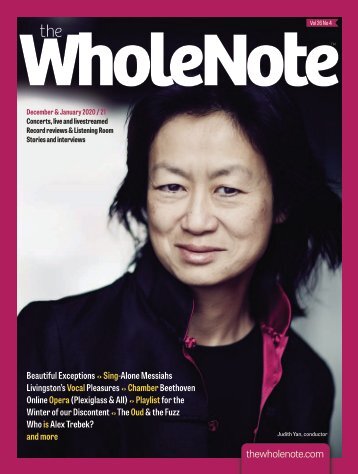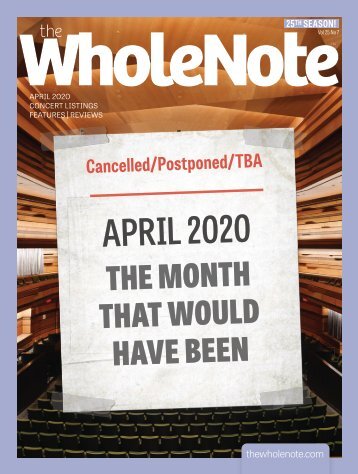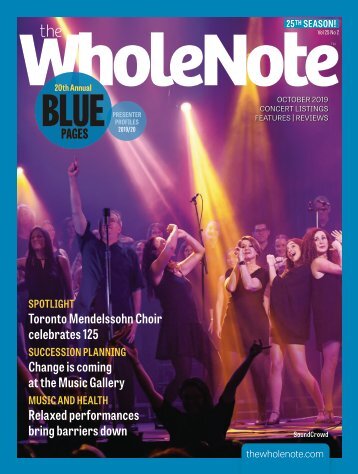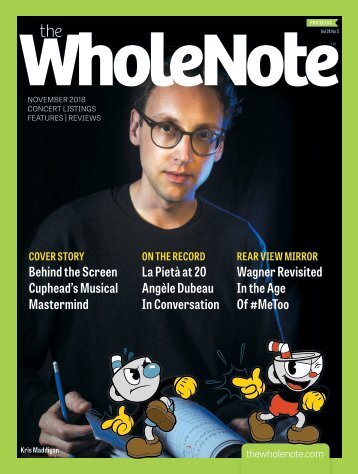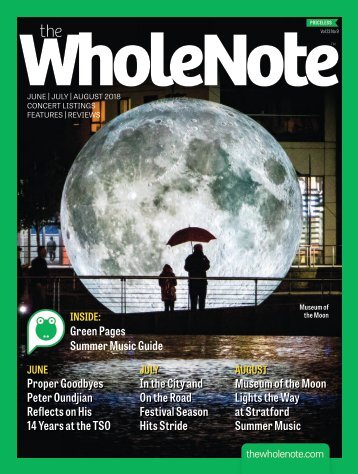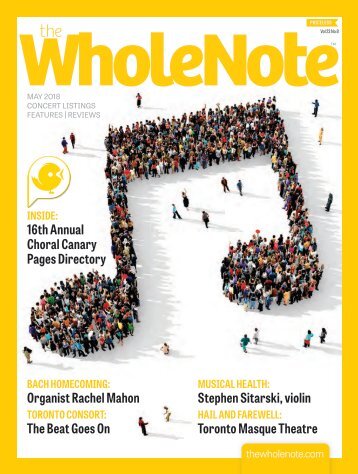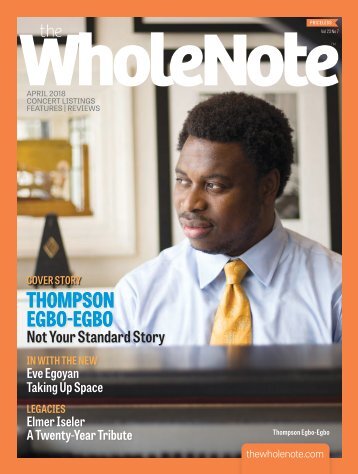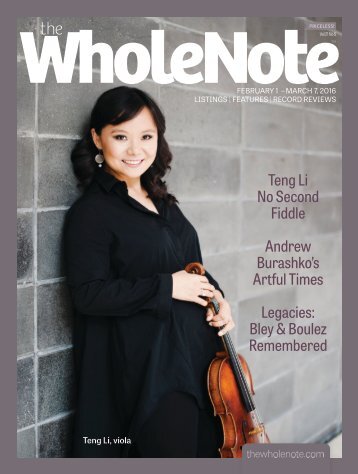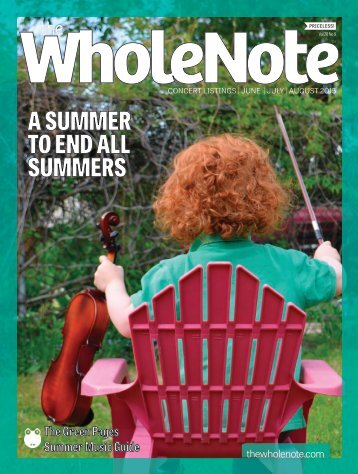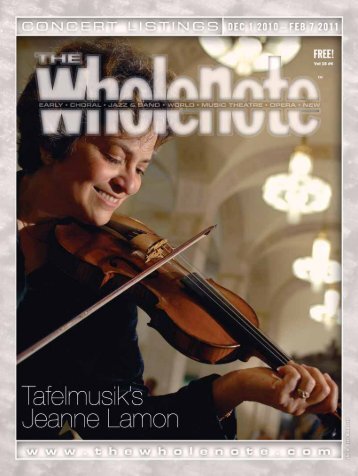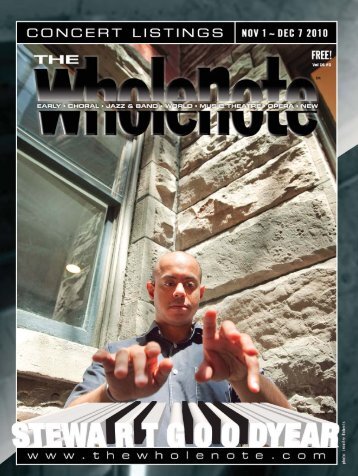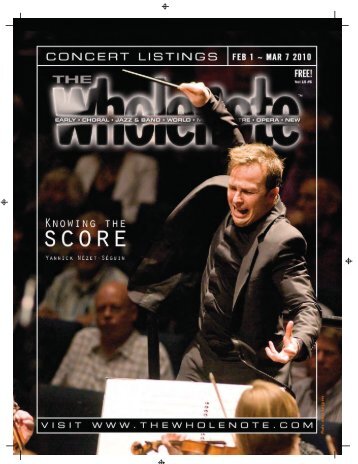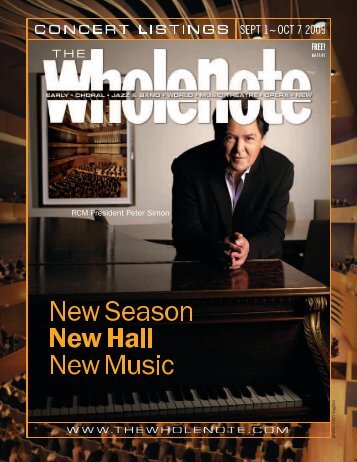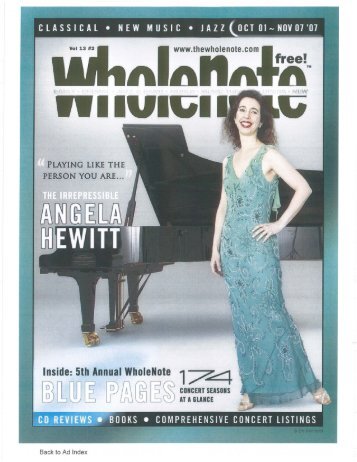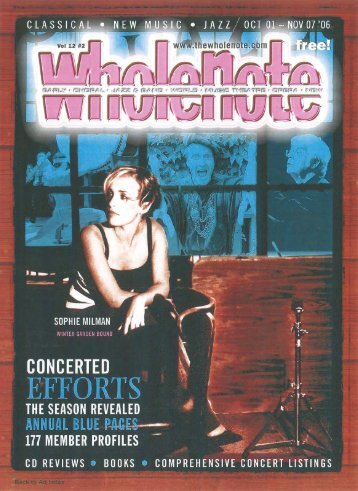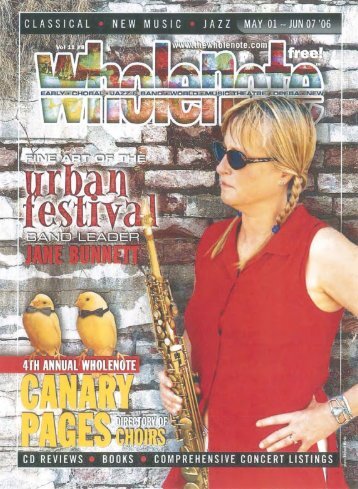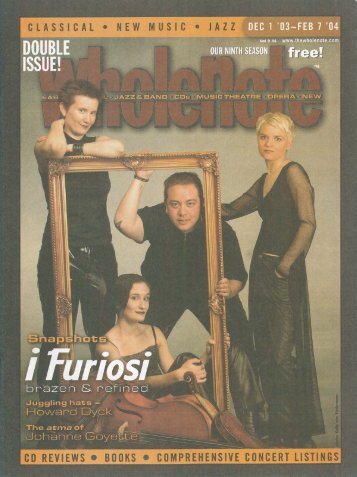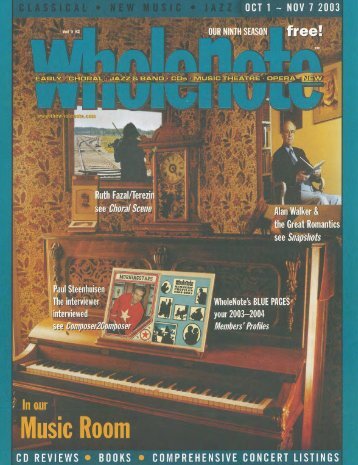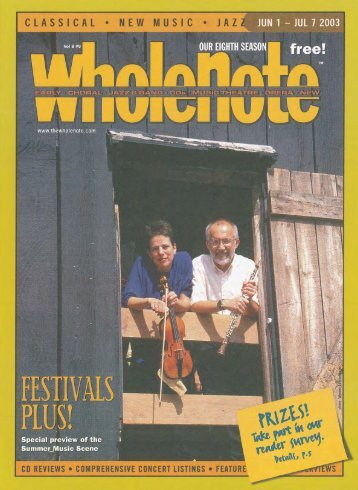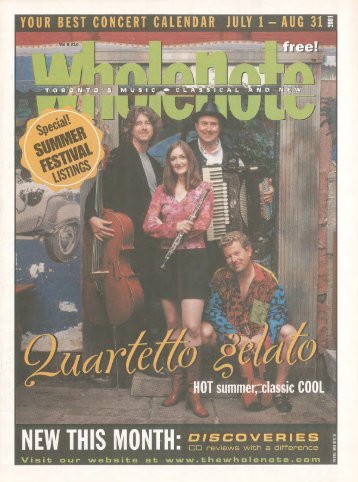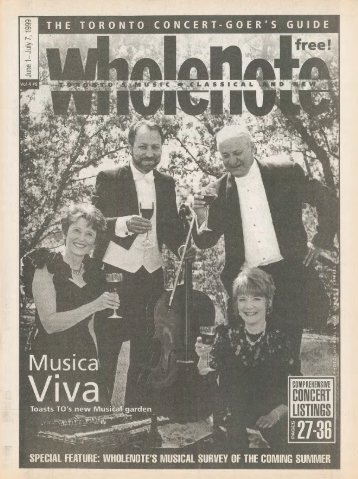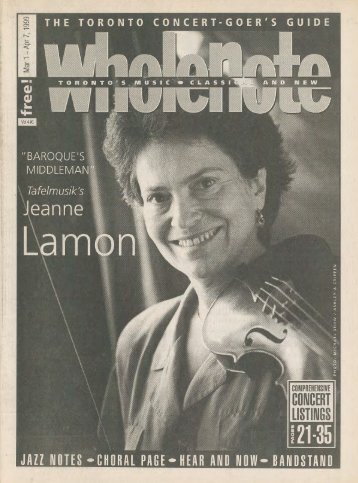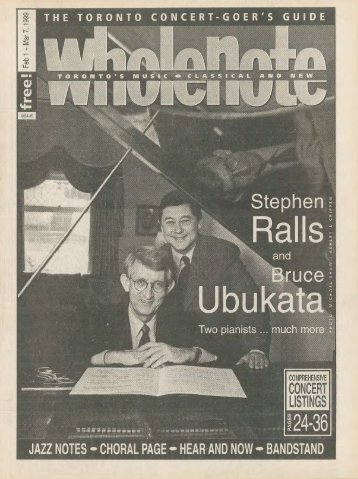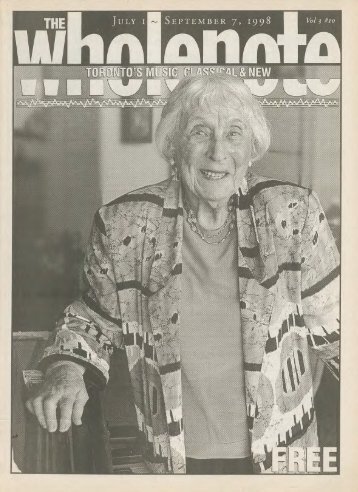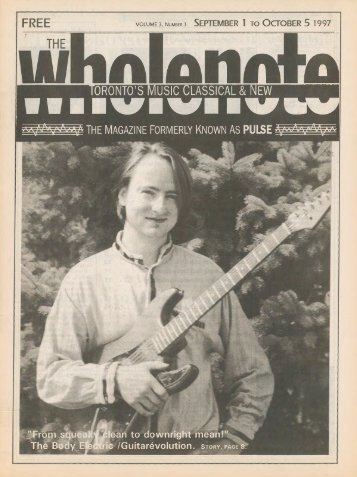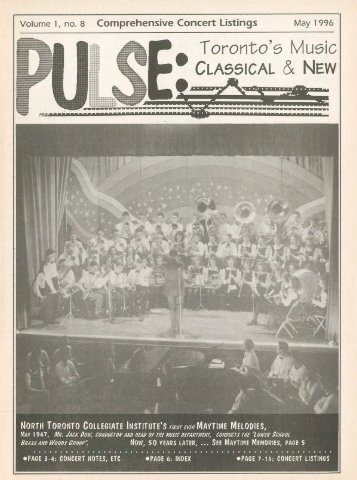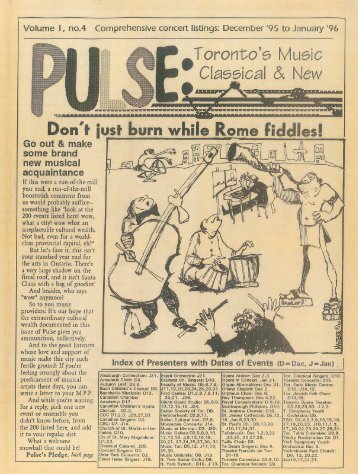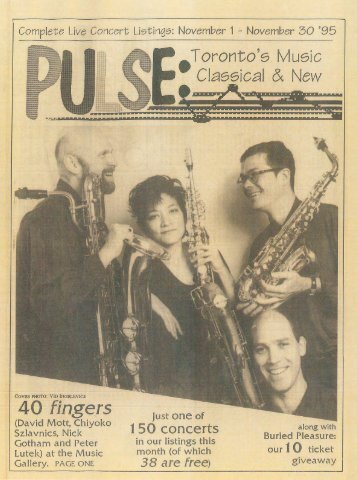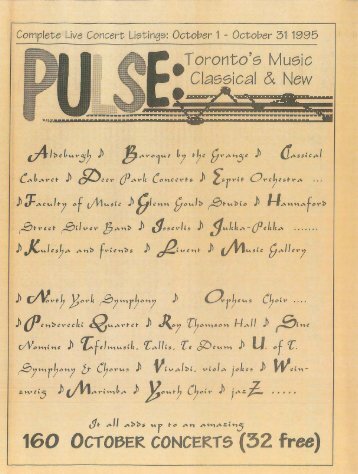Volume 14 - Issue 9 - June 2009
ecordings
ecordings reviewedEDITOR’S CORNERMarc Minkowski first came to the attentionof Toronto concert-goers through his highlysuccessful collaboration with Opera Atelier ofPurcell’s Dido and Aeneas back in 1995. Buthe has been animportant forceon the “periodperformance”scene for muchlonger thanthat, havingfounded LesMusiciensdu Louvre– Grenoble at the age of 20 in 1982. Withdozens of recordings under his belt it seemsstrange that Minkowski has waited more than25 years to tackle any of the major works ofJ. S. Bach. With the recent release of theMass in B-minor (Naïve V 5145) all that haschanged and Minkowski has embarked ona long-term projected “Bach cycle”. In theMass Minkowski uses sparse forces whichhe feels reflect those which would have beenavailable to Bach, had the work seen the lightof day during his lifetime. Instrumentallythere are just thirteen strings, pairs of windsand trumpets, solo horn for the famous duetwith the bass voice in the Quoniam tu solussanctus, timpani and continuo alternating betweenorgan and harpsichord. The ten vocalsoloists do double duty as one-voice-per-partchoristers as required, and we are presentedwith an intimate, crystalline performancelasting one hour and forty-one minutes. Recordedlast July during the fledgling Via StellaeFestival (Festival of Music of Compostelaand its Ways of Pilgrimage) in the gothicSan Domingos de Bonaval Church, Santiagode Compostela in Spain, the reverberantacoustic belies the small ensemble and we aretreated to a glorious full sound without losingany of the intimacy of the performance.The predominantly young vocal soloists areall outstanding, with highlights for me beingalto (and former soprano soloist in the ViennaBoys’ Choir) Terry Wey in the Qui sedes addextram patris with oboe d’amore providedAMOROSONew & UsedCDs Vinyl Records DVDsCLASSICAL OPERA JAZZWORLD BLUES R & B AUDIOPHILEROCK SOUNDTRACK COLLECTABLESWe pay top $$$ for yourCLASSICAL & JAZZ COLLECTIONS4 St.Patrick (at Queen near Osgoode station)www.amorosomusic.com 416-591-1313by Emmanuel Laporte and in the duet Et inunum Dominum with soprano Lucy Crowe;and Canadian tenor Colin Balzer’s Benedictuswith flute soloist Florian Cousin. Beginningthe cycle with what has been called the culminationof Bach’s life’s work will prove tobe a tough act for Minkowski to follow, buton the evidence of this maiden voyage thereare future treasures in store. Packaged as aone hundred page, trilingual hardcover book(thankfully with CD-case dimensions for easyfiling) including program notes, an interviewwith Minkowski, texts with translations andfull artist biographies, this handsome set isa welcome addition the catalogue and to mycollection.Last month the National Youth Orchestraof Canada announced the 100 membersof the 2009 edition of the orchestra selectedfrom some 550 applicants across the county.If Selections fromthe 2008 NationalTour (NYOC-2008CD www.nyoc.org) is anyindication, audienceshave a treatin store in Augustwhen this year’sorchestra, underthe direction of Alain Trudel, tours Ontarioand Quebec with stops including the NationalArts Centre and Roy Thomson Hall. Lastyear the baton was held by Trois-Rivièresnative Jacques Lacombe, who is currentlymaking his mark on the opera stages ofEurope and will make his debut at CoventGarden this summer. Lacombe leads the 2008NYOC in very strong performances of late19 th , 20 th and 21 st century works. The twodisc set begins with Kelly-Marie Murphy’sThrough the Unknown, Unremembered Gate,a work which, as I suspected but is not attributedas such in the disc’s liner notes, wascommissioned by the NYOC in which orchestramembers are required to vocalize as wellas play their instruments. It is quite an effective,dramatic work and Toronto audienceswill have a chance to hear the TSO performit during the New Creations Festival in February2010. Murphy’s piece is followed byconvincing performances of Mahler’s FirstSymphony “The Titan” (with my complimentsto the excellent horn section) andProkofiev’s “Scythian Suite”, but where theorchestra truly shines is in Richard Strauss’Ein Heldenleben. Concertmasters AyselTaghi-Zada and Kenny Wong turn in stellarperformances in the solo roles, but the work,which leaves each section of the orchestraexposed in turn, is testament to the fact thatthere are simplyno weak links inthis well-oiledmachine. Thesediscs make it easyto see why a thirdof all the players inprofessional Canadianorchestras arealumni of the NYOC which next season willcelebrate 50 years since its founding by WalterSusskind back in 1960.A couple of months ago in this column Inoted the 20th anniversary release by CatherineWilson’s Ensemble Vivant. Not contentto rest on their laurels, the ensemble hasjust released Fête Française (Opening DayODR 9379 www.openingday.com). Overthe years I must confess that I have tended toignore the group’s recordings simply as bomboniere,collections of lighter fare, all dessertand no main course. I am very pleased tofind their latest release contains a much moresubstantial menu, with little known worksby familiar composers to which we have notbeen overexposed in the past. Of particularnote for me is the Debussy Piano Trio in GMajor, an early work which was suppressedby the composer and only came to light in1980. Having had a go at this one with myown amateur trio I was very happy to find awonderful performance of it on this new recording.Although Debussy decided that thiswas not something he wanted to send out intothe world to represent him, it does provide apivotal glimpse into his development and theworld he was leaving behind with the newideas that would lead him to Impressionism.The CD also includes two other rarities, acharming collection of Alsatian folk melodiesset for piano, violin and cello by Charles-MarieWidor, a composer known to most onlyfor his organ works, and a Septet by CamilleSaint-Saëns. This latter is a backward-lookingwork which had it been composed 50 yearslater – in 1930 instead of 1880 – would havebeen called neo-classical, or more accuratelyneo-baroque. Scored for the unusual combinationof string quintet (with double bass),piano and trumpet, it was commissioned bythe organizer of a society of wind playerscalled La Trompette, and consists of a suiteof dance movements including a menuet andgavotte. Congratulations to Ensemble Vivantefor uncovering these works and presentingthem with their usual flare.We welcome your feedback and invite submissions.CDs and comments should be sentto: The WholeNote, 503 – 720 Bathurst St.Toronto ON M5S 2R4. We also encourageyou to visit our website, www.thewholenote.com, where you can find added features includingdirect links to performers, composersand record labels and “buy buttons” for onlineshopping.David OldsDISCoveries Editordiscoveries@thewholenote.comVOCALSchumannMarie-Nicole Lemieux; Daniel BlumenthalNaïve V5159What a treat to listen to a goodly measureof Schumann’s vocal music sung in full,rich and womanly contralto. Marie-NicoleLemieux, though still in her early thirties,38 WWW.THEWHOLENOTE.COM JUNE 1 - JULY 7, 2009
displays the maturityof tone anddramatic sensitivitydemanded bythis quintessentialRomantic genre.Whether playingthe youngbetrothed madebreathless bythe excitement of her approaching nuptialsor evoking the first stirrings of motherlyinstinct or the grief of widowhood, Lemieuxdelivers a stunning and credible execution.And accompaniment by Daniel Blumenthalis most expressive whilst never overreachingthe support role and yet is quite uniquein its tone and pacing compared with otherperformances of this repertoire. In additionto Frauenliebe und-Leben, Lemieux andBlumenthal perform another of Schumann’ssong cycles, Liederkreis, as well as fiveother Schumann lieder: Die Löwenbraut,Der Nussbaum, Er Ist’s, Lorelei, and Widmung.While Frauenliebe und-Leben andDie Löwenbraut work within a narrativeframework, Liederkreis and other selectionssimply evoke the atmospheric qualities ofRomanticism: nature, sentimentality andlonging, alongside a most seductive fear ofthe dark and the unknown. The obsessivespirit of Schumann’s total immersion in liederin 1840 along with his idealized perceptionof womanhood which drove his pursuitof Clara is well realized by these two exceptionalperformers.Dianne WellsHandel - SemeleCecilia Bartoli; Orchestra La Scintilla;William ChristieDecca 074 3323Suspension of disbeliefis one of the mostimportant elements topossess when watchingopera. You know whatI mean - the middleagedsoprano singingof celebrating her 16thbirthday (MadamaButterfly); the lessthanyouthful and not so slender Opheliain Hamlet; the numerous “in trousers”roles…. That is the primary reason why forcenturies now there is a tension between singers gifted with an incredible voice andnot looking the part and those who onlylook, but don’t sound the part. Some of thegreatest operatic careers were built mostlyon the looks (Renée Fleming, take a bow!).Then there is Cecilia Bartoli. Years ago,her beautiful, but not very powerful voicewas upstaged by her stunning looks. Butas her voice has matured, no suspensionof disbelief is necessary. Her performanceas Semele is a case in point. The grasping,foolish Semele instead has a problem not ofher own making - the minimalist productionby Robert Carsen. The modern, RoyalHouse of Belgium-like set and costumes donot convince as a dwelling of Jupiter and hisfavourite mortal. And yet, in the third act,both Bartoli and Charles Workman as Jupiterdeliver a gripping, powerful interplayof love and misunderstanding. The humanand divine emotions shine in their voices asthey do in the voices of the other principalsand the precise, if not very period-inspiredplaying of the familiar music of Handel.Although not a complete triumph, this is oneDVD worth keeping – if you can suspenddisbeliefRobert TomasPuccini - Madama ButterflyAngela Gheorghiu; Jonas Kaufmann;Orchestra e Coro dell’Accademia Nazionaledi Santa Cecilia; Antonio PappanoEMI Classics 2 64187 2 8In the DVD era it comes as quite a surprisethat EMI is investing in a brand new CD setof Puccini’sMadama Butterfly.EspeciallyButterfly, anopera recordedumpteen timesand favouredby some of thegreatest conductors,mostnotably Karajan who probed the depths andunearthed so much beauty in this score muchto the chagrin of its detractors who ridiculedit as shallow and sentimental. Favoured alsoby the great sopranos, Callas, Tebaldi, theunforgettable Scotto, Freni etc. who made theprincipal role their own over the years.Yet it is still important to hear new artiststackling the score and this handsomely presentednew set with demonstration sound doesjust that. From the first bar onwards we areinstantly aware of the excitement and electricityof Antonio Pappano’s brilliant, empatheticconducting, turning the orchestra into a majordramatic role in an almost Wagnerian fashion.His feeling for detail is uncanny. Feelhow he creates an almost unbearable and horrifyingnear silence just before final tragedy.Jonas Kaufmann as Pinkerton is a strong‘heldentenor’, singing out the notes, but I ammissing the Italianate charm that I am surePuccini intended. In the supporting roles,Fabio Capitanucci (Sharpless) and EnkelejdaShkosa (Suzuki) are not comparable to suchpast greats as Christa Ludwig and Giuseppede Luca. However, the second major factorthat makes this recording so extraordinary isfamed Puccini heroine Angela Gheorghiu inthe title role. It requires a singer-actress ofthe highest caliber to portray the developmentof a 15 year old geisha into a lover, a proudmother and later a tragic heroine. She accomplishesthis daunting task beautifully with amemorable performance.Janos GardonyiEARLY AND PERIODPERFORMANCEThe Queen - Music for Elizabeth IToronto ConsortMarquis 81387 (www.marquisclassics.com)In light of the recent revival of popular interestin “The Tudors”, this is a most timelyrelease for the Toronto Consort. Followingon the heels of recent staging of this repertoire,the CD is beautifully performed withexquisite sound engineering by Ed Marshall.As ever, in the pursuit of historical authenticity,director David Fallis has been thoroughin his research, to the point of engaging ProfessorDavid Klausner of the University ofToronto to assistwith Elizabethanpronunciation,a feature that ismost engagingin and of itself.The spirit of theElizabethan courtis recapturedwith its love formusic, dancing, playfulness and glorificationof heroic exploits, realm and monarch, withJUNE 1 - JULY 7, 2009 WWW.THEWHOLENOTE.COM 39
- Page 5 and 6: Volume 14 #9: June 1 - July 7, 2009
- Page 8 and 9: The Children’s CrusadeLeads the S
- Page 10 and 11: FREE CONCERTS IN THERICHARD BRADSHA
- Page 12 and 13: Green Pages Summer Music GuideLeadi
- Page 14 and 15: Bunnett’s Embracing Voices tour m
- Page 16: eat by beat: world musicA climate c
- Page 20 and 21: Another opportunity was presented w
- Page 22 and 23: WHOLENOTE LISTINGSSECTIONS 1 - 4: I
- Page 24 and 25: ... 1:CONCERTS: Toronto and GTA—
- Page 26 and 27: toronto children’s chorusElise Br
- Page 28 and 29: ... 1:CONCERTS: Toronto and GTA—
- Page 30 and 31: Cowan, organ. All Saints Kingsway A
- Page 32 and 33: Kenny Simon Guitar Solo, Dino Domin
- Page 36 and 37: Theatre; Erin Helyard, director. Ch
- Page 40 and 41: selections by Dowland, Morley, Camp
- Page 42 and 43: The eighteen-piece ensemble breathe
- Page 44 and 45: apt given the inspiration for the s
- Page 46 and 47: Nagata Shachu at the Collingwood an
- Page 48 and 49: artistic delights for your enjoymen
- Page 50: theproudly presentsMovies Embracing
Inappropriate
Loading...
Mail this publication
Loading...
Embed
Loading...
























